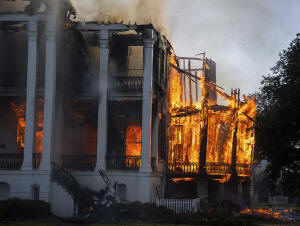Video of the Nottoway Plantation fire sparks jubilation. It's about
anger and pain over slavery, too
[May 21, 2025]
By FERNANDA FIGUEROA and AARON MORRISON
After a fire engulfed a mansion at Louisiana's Nottoway Plantation, one
of the largest remaining pre-Civil War houses in the Deep South where
scores of enslaved Africans labored, video footage of the combusted
landmark lit the internet ablaze with mass jubilation and consternation
over the weekend.
For some, it was a moment to celebrate what they saw as
centuries-deferred vengeance for enslaved ancestors. There was no
shortage of memes and humorous social media posts to ignite the
celebrations: from video of the plantation’s burning mansion set to the
R&B hit song “Let It Burn” by Usher to other footage with the volume of
burning wood cranked all the way up to trigger a cozy autonomous sensory
meridian response.
“Went and watched (Nottoway Plantation) burn to the ground!” historian
Mia Crawford-Johnson wrote in the Instagram caption of a grinning selfie
taken Thursday across from the burned mansion near the banks the
Mississippi River.
For others, it was a moment of sadness. Nottoway Plantation has for
years been a venue for weddings and other events celebrating cherished
milestones. Not to mention, proof of the ingenuity and skill of the
enslaved people held on the plantation has been reduced to ashes.
Preservationists say the jubilant reactions to the charred mansion
reflect the trauma and anger many people, especially Black Americans,
still carry over the history and legacy of chattel slavery in the United
States. Antebellum era plantations were built under grueling conditions
on the backs of enslaved people, and many are now sites of honor on the
National Register of Historic Places.

Some plantations try to ignore their past
But some plantations also de-emphasize or overlook their full histories,
foregoing mentions of slavery altogether. That is why the “good
riddance” sentiment seemed to outweigh expressions of grief over
Nottoway Plantation, which makes no mention of enslaved former
inhabitants on its website.
Many sites of enslavement in the U.S. have been repurposed as places
that actively participate in the erasure of their history, said Ashley
Rogers, executive director of the Whitney Plantation Museum, located 40
miles (65 kilometers) west of New Orleans. She said the burning of
Nottoway is not actually part of the movement for preservation, since
nothing was truly being done on the property to tell its full history.
“It was a resort,” Rogers said. “I don’t know that it being there or not
being there has anything to do with how we preserve the history of
slavery. They already weren’t.”
Joseph McGill, executive director of the Slave Dwelling Project, a
nonprofit focused on helping the U.S. acknowledge its history with
slavery, said the reaction from the Black community about Nottoway
burning represents years of complicated emotions related to plantations.
But as a preservationist, McGill said it is unfortunate Nottoway burned
down, even if it was failing at telling history.
“I would like to see buildings preserved so that those buildings could
tell the stories of all the people who inhabited those spaces,” McGill
said. “We have been failing at that, but at least when the buildings are
there the opportunity always exists to do the right thing.”
Nottoway Plantation became a resort and event venue
Before the fire, Nottoway was a resort and event venue, and its website
described it as “the South’s largest remaining antebellum mansion.”
Iberville Parish President Chris Daigle called the plantation “a
cornerstone of our tourism economy and a site of national significance.”
[to top of second column]
|

The north wing of the Nottoway Plantation starts to collapse as
crews battle the fire on Thursday, May 15, 2025 in White Castle, La.
(Michael Johnson /The Advocate via AP)

The sprawling property exists on a former sugar plantation owned by
sugar baron John Hampden Randolph. Located about 65 miles (105
kilometers) northwest of New Orleans, the 53,000-square-foot
(4,924-square-meter) mansion had a three-story rotunda adorned with
giant white columns and hand-carved Italian marble fireplaces,
according to a description on its website. A brochure advertises 40
overnight rooms, a honeymoon suite, a lounge, fitness center,
outdoor pool and cabana, among other resort features.
In 1860, 155 enslaved people were held at the property, National
Park Service records show.
After the blaze, which drew an emergency response from nearly a
dozen fire departments from surrounding towns, the property’s owner
said the fire had led to a “total loss” and that he hoped to rebuild
the mansion.
Rogers said it is unfortunate Nottoway's mansion burned down, as it
did serve as a testament to the “skill of enslaved craftspeople and
free people of color who built it and who did a lot of the
incredible design work that was inside of that building.”
There are plenty of plantations, unlike Nottoway, that do not allow
weddings or other celebratory events. For example, the Whitney,
which documents slavery at a pre-Civil War plantation, draws tens of
thousands of visitors annually and is known for centering the
stories of enslaved people.
The Nottoway fire has also restarted a public discourse over
plantations. Rogers, the Whitney museum director, said this is not
new discourse, but can feel like such because there are not many
places where productive conversations can be had about slavery and
how to tell its history.
Racism and slavery dominate cultural debates
How, where and when to talk about the history of U.S. racism and
slavery has dominated political and cultural debates in recent
years. An executive order issued in March by the Trump White House
seeks to root out “divisive, race-centered ideology” in the
Smithsonian Institution, which operates a broad range of cultural
centers in Washington. Among the order's targets is the National
Museum of African American History and Culture, a popular
Smithsonian attraction that chronicles chattel slavery, Jim Crow
segregation and its lingering effects.

Relatedly, plantations and other national historic sites with ties
to civil rights have long been places where visitors and descendants
of enslaved people go to learn about the past. But they are also
places where visitors may encounter naysayers and deniers
challenging the tour guide's presentation about slavery.
Rogers said there are plenty of others sites besides Nottoway
accurately telling Black history that need to be preserved.
“I don’t think one plantation burning down is going to change how we
talk about slavery in this country,” she said. “All it does is
exposes wounds that are already there.”
All contents © copyright 2025 Associated Press. All rights reserved |